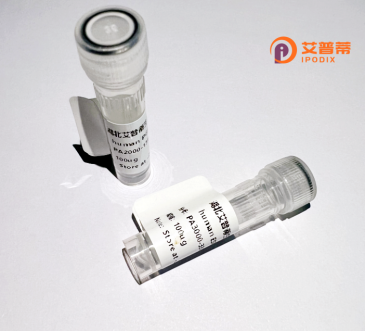
| 纯度 | >90%SDS-PAGE. |
| 种属 | Human |
| 靶点 | RSAD2 |
| Uniprot No | Q8WXG1 |
| 内毒素 | < 0.01EU/μg |
| 表达宿主 | E.coli |
| 表达区间 | 1-361 aa |
| 活性数据 | MWVLTPAAFA GKLLSVFRQP LSSLWRSLVP LFCWLRATFW LLATKRRKQQ LVLRGPDETK EEEEDPPLPT TPTSVNYHFT RQCNYKCGFC FHTAKTSFVL PLEEAKRGLL LLKEAGMEKI NFSGGEPFLQ DRGEYLGKLV RFCKVELRLP SVSIVSNGSL IRERWFQNYG EYLDILAISC DSFDEEVNVL IGRGQGKKNH VENLQKLRRW CRDYRVAFKI NSVINRFNVE EDMTEQIKAL NPVRWKVFQC LLIEGENCGE DALREAERFV IGDEEFERFL ERHKEVSCLV PESNQKMKDS YLILDEYMRF LNCRKGRKDP SKSILDVGVE EAIKFSGFDE KMFLKRGGKY IWSKADLKLD W |
| 分子量 | 42.1 kDa |
| 蛋白标签 | His tag N-Terminus |
| 缓冲液 | PBS, pH7.4, containing 0.01% SKL, 1mM DTT, 5% Trehalose and Proclin300. |
| 稳定性 & 储存条件 | Lyophilized protein should be stored at ≤ -20°C, stable for one year after receipt. Reconstituted protein solution can be stored at 2-8°C for 2-7 days. Aliquots of reconstituted samples are stable at ≤ -20°C for 3 months. |
| 复溶 | Always centrifuge tubes before opening.Do not mix by vortex or pipetting. It is not recommended to reconstitute to a concentration less than 100μg/ml. Dissolve the lyophilized protein in distilled water. Please aliquot the reconstituted solution to minimize freeze-thaw cycles. |
以下是关于重组人RSAD2(Viperin)蛋白的3篇参考文献概览:
---
1. **标题**:*Structural basis of antiviral activity of the interferon-induced protein viperin*
**作者**:Fenwick MK 等
**摘要**:通过X射线晶体学解析了RSAD2(Viperin)的蛋白结构,揭示其通过催化合成抗病毒代谢物ddhCTP,抑制RNA病毒复制(如甲型流感病毒)的分子机制。
2. **标题**:*Viperin Restricts Zika Virus and Tick-Borne Encephalitis Virus Replication by Targeting NS3 for Proteasomal Degradation*
**作者**:Panayiotou C 等
**摘要**:研究发现RSAD2通过靶向黄病毒属病毒(如寨卡病毒、蜱传脑炎病毒)的非结构蛋白NS3.促进其泛素化降解,从而抑制病毒复制。
3. **标题**:*Human RSAD2/Viperin accelerates influenza A virus reproduction by modulating DAFM*
**作者**:Li Y 等
**摘要**:揭示RSAD2在不同细胞类型中的双刃剑作用:虽通过干扰素途径抑制部分病毒,但在流感病毒感染中可能通过影响脂代谢通路增强病毒释放,提示其功能复杂性。
---
建议通过PubMed或Google Scholar以“RSAD2 antiviral”“Viperin structure”等关键词检索最新研究。
Recombinant human RSAD2 (Radical S-Adenosyl Methionine Domain Containing 2), also known as viperin (virus inhibitory protein, endoplasmic reticulum-associated), is a multifunctional protein encoded by the RSAD2 gene. It plays a critical role in innate immunity, particularly in antiviral defense mechanisms. RSAD2 is induced by type I and III interferons (IFNs) in response to viral infections, and it exerts broad-spectrum antiviral activity against diverse viruses, including HIV, influenza, hepatitis C virus (HCV), and dengue virus. Its mechanisms involve disrupting viral replication through multiple pathways: interfering with viral membrane assembly, depleting cellular nucleotide pools, or interacting with host proteins to modulate signaling pathways.
Structurally, RSAD2 contains an N-terminal amphipathic helix, a central radical S-adenosylmethionine (SAM) domain, and a C-terminal domain critical for its subcellular localization. The SAM domain facilitates its enzymatic activity, which is linked to the synthesis of antiviral metabolites like ddhCTP, a nucleotide analog that inhibits viral RNA polymerases. Recombinant RSAD2 is typically produced in Escherichia coli or mammalian expression systems for functional studies, enabling researchers to explore its biochemical properties, interaction networks, and therapeutic potential. Beyond antiviral roles, emerging evidence suggests RSAD2 involvement in immune regulation, lipid metabolism, and cancer, though these functions require further characterization. Its dual roles as a direct antiviral effector and immune modulator make RSAD2 a compelling target for studying host-pathogen interactions and developing broad-spectrum antiviral strategies.
×